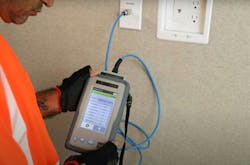Ask for preproduction cable tests in every smart building IoT project

Smart buildings and related IoT projects are generally seen as examples of modern technology that create operational efficiencies, improve occupant health and safety, and automate manual maintenance processes. Before any such benefit can be realized, however, a smart building must possess the copper and/or fiber optic cabling that can support digital transformation goals in production environments. Unfortunately, a lack of testing of new and existing cabling in preproduction “load” scenarios can lead to situations in which the technology riding across the physical cable plant suffers because of poor network performance.
Smart building cabling “gotchas”
“Anyone who works in enterprise IT knows that cabling issues crop up at the most inopportune times,” says Lisa Schwartz, director of business development at Singapore-based test equipment provider AEM. With the recent flood of IoT sensors for smart building application, she continues, owners often assume they can fully trust copper and fiber cabling that is certified to the cable manufacturer’s requirements. “While post-install certification tests do offer warranty protections against physical cable and install defects,” she says, “there’s no telling how the cable plant will operate once put to use within real-world production environments.”
Cable-related performance issues that result in suboptimal performance once IoT devices are connected and transmitting/receiving data can occur under several conditions. Many IoT devices today require multigigabit Ethernet speeds to handle the increased data load the devices must send and receive at any given moment. Even with the proper type and quality of cabling—and with proper certification tests performed—multigigabit links are far more sensitive to internal or external electromagnetic interference compared to connections that operate at speeds of 1Gbps or lower.
More IoT sensors are using Power over Ethernet (PoE) at the access layer of an enterprise network—while also demanding more wattage than in the past. The combination of more PoE devices and more power being delivered can cause interference with data transport signaling to the point where packets must be retransmitted. For real-time streaming applications, the added packet loss, increased latency or jitter, and lowered bandwidth capacity can reduce the usefulness of many smart building IoT applications.
Setting your project plan up for success
Preproduction cable tests are designed to simulate how an endpoint (such as a smart building IoT sensor) will operate in real-world conditions. These tests can be performed after traditional cable certification tests and immediately after network hardware is installed and configured, Schwartz says: “Tests are run between the production networking hardware and specialized cable test equipment that simulate various IoT devices. This way, any interference caused by things such as PoE delivery, adjacent lighting, or crosstalk between cables in a bundle can be identified and resolved prior to relying on the cable plant for smart building purposes.”
Increased buy-in for preproduction cable tests
Though a relatively new concept, preproduction cable tests are gaining popularity due to the added need for multigigabit and PoE at the network access edge. As a result, a smart building IoT project should require the cable plant installation company not only to certify all newly installed cabling for warranty purposes, but also to run preproduction tests and make any necessary adds or changes prior to the attachment of smart-building sensors. This small and relatively inexpensive cable verification add-on can be the difference between a successful and unsuccessful project.
For more news, projects, and profiles in the smart buildings ecosystem, subscribe to the SBT newsletter and follow us on LinkedIn, Twitter, and Facebook.
About the Author

Andrew Froehlich
Contributor
As a highly regarded network architect and trusted IT consultant with worldwide contacts, Andrew Froehlich counts over two decades of experience and possesses multiple industry certifications in the field of enterprise networking. Andrew is the founder and president of Colorado-based West Gate Networks, which specializes in enterprise network architectures and data center build-outs. He’s also the founder of an enterprise IT research and analysis firm, InfraMomentum. As the author of two Cisco certification study guides published by Sybex, he is a regular contributor to multiple enterprise IT-related websites and trade journals with insights into rapidly changing developments in the IT industry.